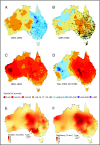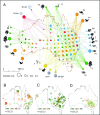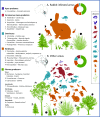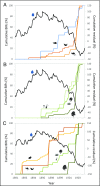Historical reconstruction unveils the risk of mass mortality and ecosystem collapse during pancontinental megadrought
- PMID: 31308227
- PMCID: PMC6681765
- DOI: 10.1073/pnas.1902046116
Historical reconstruction unveils the risk of mass mortality and ecosystem collapse during pancontinental megadrought
Abstract
An important new hypothesis in landscape ecology is that extreme, decade-scale megadroughts can be potent drivers of rapid, macroscale ecosystem degradation and collapse. If true, an increase in such events under climate change could have devastating consequences for global biodiversity. However, because few megadroughts have occurred in the modern ecological era, the taxonomic breadth, trophic depth, and geographic pattern of these impacts remain unknown. Here we use ecohistorical techniques to quantify the impact of a record, pancontinental megadrought period (1891 to 1903 CE) on the Australian biota. We show that during this event mortality and severe stress was recorded in >45 bird, mammal, fish, reptile, and plant families in arid, semiarid, dry temperate, and Mediterranean ecosystems over at least 2.8 million km2 (36%) of the Australian continent. Trophic analysis reveals a bottom-up pattern of mortality concentrated in primary producer, herbivore, and omnivore guilds. Spatial and temporal reconstruction of premortality rainfall shows that mass mortality and synchronous ecosystem-wide collapse emerged in multiple geographic hotspots after 2 to 4 y of severe (>40%) and intensifying rainfall deficits. However, the presence of hyperabundant herbivores significantly increased the sensitivity of ecosystems to overgrazing-induced meltdown and permanent ecosystem change. The unprecedented taxonomic breadth and spatial scale of these impacts demonstrate that continental-scale megadroughts pose a major future threat to global biodiversity, especially in ecosystems affected by intensive agricultural use, trophic simplification, and invasive species.
Keywords: Federation Drought; ecosystem collapse; mass mortality; megadrought; trophic impact.
Copyright © 2019 the Author(s). Published by PNAS.
Conflict of interest statement
The authors declare no conflict of interest.
Figures





References
-
- Naumann G., et al. , Global changes in drought conditions under different levels of warming. Geophys. Res. Lett. 45, 3285–3296 (2018).
-
- Zhao T., Dai A., The magnitude and causes of global drought changes in the 21st century under a low-moderate emissions scenario. J. Clim. 28, 4490–4512 (2015).
-
- Stahle D. W., et al. , Major Mesoamerican droughts of the past millennium. Geophys. Res. Lett. 38, L05703 (2011).
-
- Cook B. I., Smerdon J. E., Seager R., Cook E. R., Pan-continental droughts in North America over the last millennium. J. Clim. 27, 383–397 (2014).
Publication types
MeSH terms
LinkOut - more resources
Full Text Sources
Other Literature Sources

